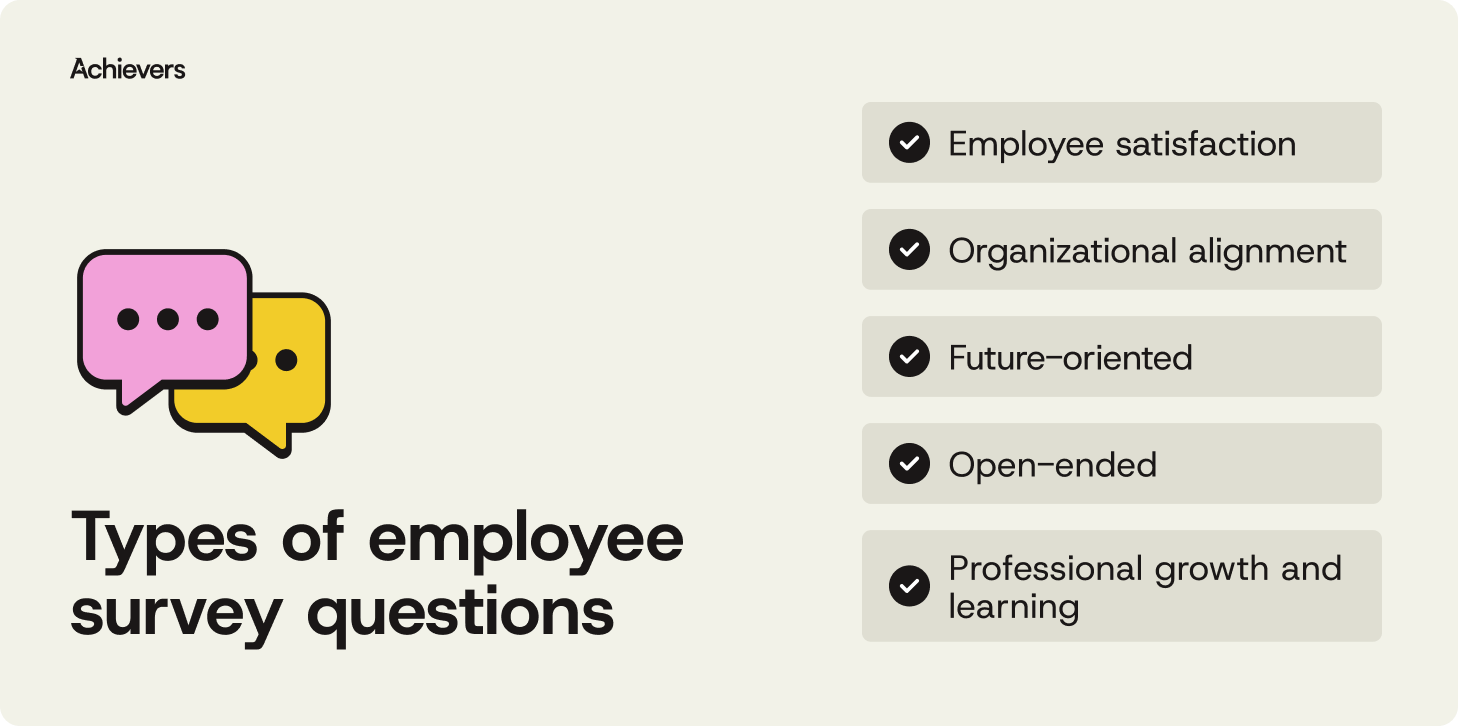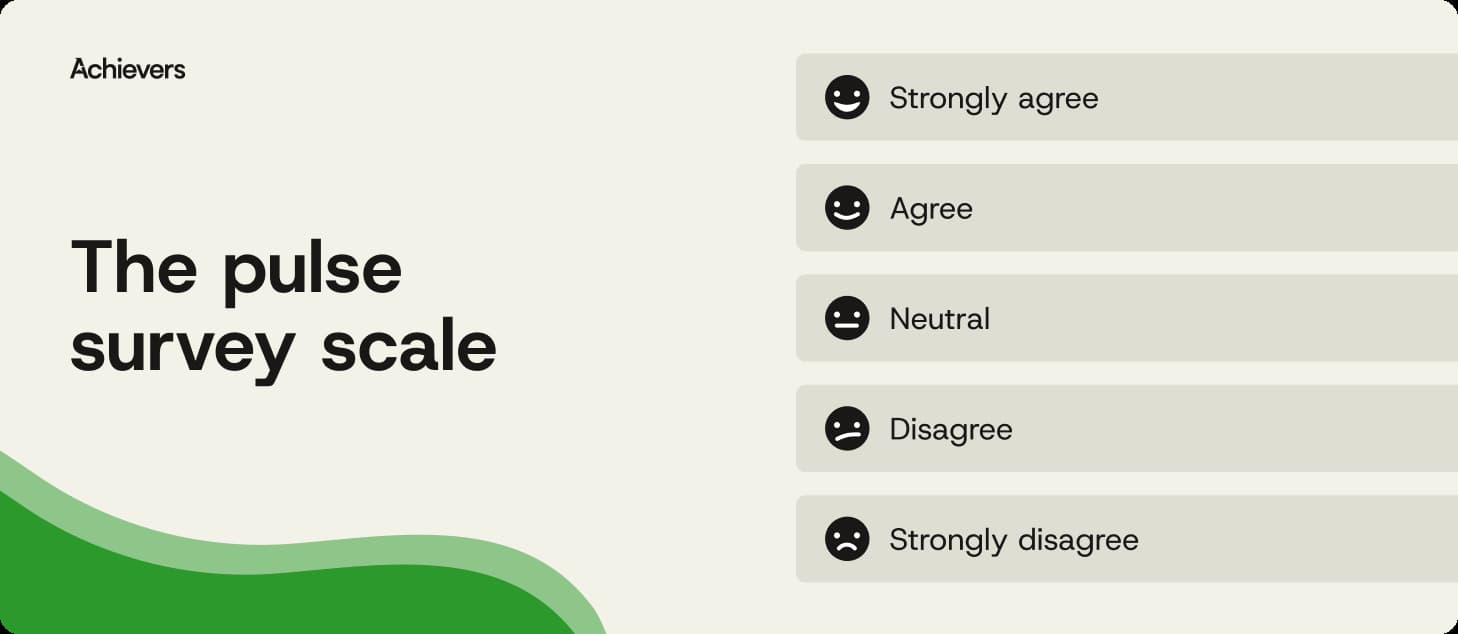Table of contents
Create a culture that means business™
Schedule a demo with an Achievers solution expert today.
An employee engagement survey is one of the most reliable ways to understand — and improve — how your people are really doing. Engaged employees drive performance, motivation, and productivity, yet disengagement remains a massive drag on organizations. In fact, it costs the global economy an estimated $8.9 trillion in lost productivity every year. Gallup’s State of the Global Workforce Report puts the picture into focus: only 23% of employees say they feel “engaged,” while 62% are “not engaged,” and 15% are “actively disengaged.”
It’s a clear signal that many organizations need to listen more closely. Employee engagement surveys give leaders a straightforward way to gather honest feedback, spot what’s working, and surface the areas that need attention — all with the goal of supporting a more connected, motivated workforce.
Why use surveys to measure employee engagement?
Employee engagement surveys do something few tools can pull off — they get people talking honestly. When feedback is anonymous, employees are far more likely to say what they really think, not just what sounds good in a meeting. And that candor gives leaders a sharper, more human picture of how people are feeling, what’s fueling them, and what’s quietly holding them back.
Here are a few reasons why you should use surveys to measure employee engagement:
- Spot issues early: Think of surveys as an early-warning system for culture. They reveal friction points — within teams, roles, or the organization as a whole — before they have a chance to grow roots. The sooner you spot the problem, the faster you can support the people feeling it.
- Track progress: Engagement isn’t static, and your surveys shouldn’t be either. Regular check-ins make it easy to see what’s improving, what’s slipping, and where your efforts are actually making an impact. Whether you run quick pulses or deeper dives, trends over time tell the real story.
- Show you care: Asking for feedback is powerful. Acting on it is even better. When employees see that their input drives real change, it builds trust — and trust fuels the kind of engagement, connection, and everyday behaviors that shape stronger cultures.
What can you measure with employee engagement surveys?
Engagement surveys give you a clear look into the day-to-day experiences shaping your workforce — the well-being, motivation, and connection that often go unseen until they impact performance. When done well, they reveal not just how people feel, but why they feel that way.
Some of the key metrics to keep in mind are:
- Employee commitment: Measures how invested employees feel in their role and the organization. High commitment often shows up as stronger performance, resilience, and a willingness to go the extra mile — without burning out along the way.
- Motivation: Gauges the energy employees bring to their work. Strong motivation signals a healthy workplace culture; low motivation is a cue to look deeper at what’s draining momentum.
- Job satisfaction: Evaluates how employees feel about their work, compensation, and environment. It’s one of the clearest indicators of whether they’re thriving or quietly considering other options.
- Connection to the company mission: Gauges how well employees understand — and believe in — your goals and strategy. When people feel aligned, they’re more likely to contribute in meaningful, purpose-driven ways.
- Career development opportunities: Reveals whether employees see a future with your organization. If growth feels out of reach, engagement and retention almost always follow suit.
- Cultural fit: Identifies how comfortable and supported employees feel within your culture, including whether their efforts are consistently recognized. A strong sense of belonging often predicts stronger performance and improved employee turnover.
23 employee engagement survey question examples
Asking the right questions is key to getting meaningful insights from your employee engagement survey. Here are 23 examples to help you get started:

Employee satisfaction survey questions
What does employee satisfaction look like in your organization, and how can you measure it? These questions help you understand what employees are really experiencing day to day:
1. How do you feel about work today?
This simple check-in gives employees permission to be honest about how they’re doing right now. It can spark bigger conversations about well-being and help you notice patterns across teams or roles. Visual scales — like a range of smiley icons — make it easier for people to share without overthinking it, and an optional comment field lets those who want to go deeper do so comfortably.
2. Would you recommend us to your friends as an employer?
Employees are powerful brand ambassadors — for better or worse. If they love working here, they’ll say so. If they don’t, they’ll definitely say so. This question helps you understand how the employee experience really feels and gives you a helpful benchmark to track over time.
3. Do you feel excited about coming to work?
Excitement is a great indicator of engagement. If someone’s fired up about their work, it usually shows. If not, a neutral answer can be a clue that something’s missing — and a chance to ask what would help them feel more energized.
4. Are you proud of working for the company?
Pride often reflects connection — to the work, to the mission, and to the team. When employees feel proud, they talk about their work in a way that inspires trust. If pride is low, a comment box can help uncover what’s getting in the way.
5. Are you satisfied with your current compensation and benefits?
Pay and benefits aren’t the whole story, but they do shape how supported employees feel. This question helps pinpoint whether compensation feels fair and whether your benefits match what people actually value.
6. Do you enjoy working with your team?
Strong teams make work feel lighter. When people enjoy the group they’re part of, it boosts belonging and everyday engagement. Comments can highlight great team dynamics — or surface concerns that may need thoughtful follow-up.
Organizational alignment employee engagement survey questions
These questions take a step back and explore how employees connect to your organization as a whole — your mission, your culture, and the way leadership shows up:
7. Do you find your work for [organization] meaningful?
Meaning matters. When employees can see the impact of their work, they’re more resilient, more invested, and more likely to stay. This question helps you understand whether that sense of purpose is landing.
8. Does the company’s vision and values inspire you?
This question shows whether employees understand your mission statement — and feel connected to it. If your values don’t feel clear or inspiring, it often shows up here. You can even include your values in the survey to help gauge awareness.
9. Do others provide you with recognition for your accomplishments at work?
Recognition goes a long way. Most employees want to feel appreciated for what they contribute — especially by their manager. If recognition is lacking, motivation usually dips. This question highlights whether appreciation is showing up consistently.
10. Does our workplace culture foster a comfortable, supportive work environment?
Culture is built in everyday moments — not just through announcements or slide decks. This question helps you understand whether employees feel supported and whether the environment you’re aiming for matches what they’re experiencing.
11. Is leadership invested in and contributing to your culture initiatives?
Employees look to leaders to set the tone. When leadership actively participates in culture-building, it sends a powerful signal about what the organization truly values. This question helps you understand whether employees feel that alignment from the top.
Future-oriented employee engagement survey questions
These questions help you get ahead of concerns that might otherwise stay quiet — the moments when talented people start to feel stuck, overlooked, or unsure about what comes next.
12. Do you see yourself working here in a year?
Nearly half of professionals reportedly considered quitting their jobs in 2024, which makes this question more important than ever. A simple comment box or pulse survey can give people space to share their “why,” which often reveals opportunities to strengthen connection and retention long before someone considers leaving.
13. Does your work challenge you and aid your development?
Employees want to grow — but they want support, not unnecessary hurdles. With 50% of employees believing their company needs more growth opportunities, this question helps uncover whether employees feel stretched in the right ways — supported, learning, and building new skills — or if they’re hitting walls without the guidance they need.
14. Do you see a path for career advancement?
If employees can’t picture their next step, they’re more likely to look for it somewhere else. This question helps you understand whether advancement is unclear, inaccessible, or too limited.
15. Do you have the tools needed to maximize your potential here?
People want to do great work — they just need the right support to get there. This question sheds light on what might be slowing them down and gives you actionable clues about the resources, technology, or guidance they’re missing.
16. Have you recently thought about leaving?
It’s a tough question, but an important one. Giving employees anonymity (and offering options like “Not sure”) helps them answer honestly. Honest feedback here can reveal deeper cultural or workload challenges that need attention before they turn into turnover.
17. Has anyone at the company asked about and expressed support for your career goals?
Feeling seen matters — especially when it comes to career growth. This question uncovers whether managers and leaders are having the conversations employees crave. You can also encourage employees to connect with HR or a manager to continue the conversation if needed.
Open-ended employee engagement survey questions
These questions are a great way to uncover nuance, context, and ideas you might not hear otherwise. It’s always worth including a few of these in every survey so employees feel heard in a more meaningful way.
18. What practices do we need to change?
This question invites employees to share honest recommendations about what’s not working. When people feel like their feedback leads to real change, engagement naturally rises — because they feel like active contributors, not just passengers.
19. Are there any problems with our culture?
Culture isn’t static, and employees often see things leaders can’t. This question encourages them to share where things feel misaligned or uncomfortable. Their insights can help you pinpoint opportunities to strengthen your culture in practical, people-centered ways.
20. How can we help improve your engagement at work?
Sometimes the simplest approach is the most powerful: ask employees directly what they need. This question opens the door to easy wins, bigger culture improvements, and new ideas you may not have considered.
Professional growth and learning opportunities
Questions about growth and learning help you understand whether employees feel supported in building their skills and shaping their careers.
21. Do you feel encouraged to learn new skills and grow professionally?
This question reveals whether employees feel backed in their development. Support for learning sends a strong signal that the organization cares about long-term growth, not just day-to-day tasks.
22. Are there sufficient training programs or resources available to help you succeed in your role?
Great performance depends on great support. This question shows whether employees feel they have the tools, programs, and guidance they need to do their best work — and where additional resources might make a meaningful difference.
23. Do you have clear career development paths or mentorship opportunities within the organization?
Clarity creates confidence. This question helps you understand whether employees see a real path forward, along with people who can help guide them. When that roadmap feels accessible, engagement and retention improve.
How to design your employee engagement survey questions
Designing great questions isn’t just about filling a list — it’s about creating space for employees to be honest about their experience. The right mix of questions helps you understand not only how people say they feel, but what’s really shaping their day-to-day.
Quantitative employee engagement survey questions
Quantitative questions are your go-to for spotting patterns and tracking progress over time. They turn gut feelings into clear, trackable data — the kind you can compare across teams, roles, and moments in the year. These questions usually rely on rating scales or multiple-choice answers, keeping things simple for employees and easy to analyze for you.
Examples include:
1. On a scale of 1 to 10, how satisfied are you with your current role?
2. How likely are you to recommend our organization as a great place to work?
- Very likely
- Somewhat likely
- Neutral
- Somewhat unlikely
- Very unlikely
3. How often do you receive recognition for your work?
- Daily
- Weekly
- Monthly
- Rarely
- Never
Qualitative employee engagement survey questions
Qualitative questions let employees share the “why” behind their answers — the stories, context, and perspectives that numbers alone can’t surface. These questions invite people to speak openly about their experience, which often reveals the insights that make the biggest impact.
Examples include:
- What motivates you to do your best work here?
- Are there any challenges or frustrations in your role that affect your engagement? Please explain.
- What could we do better to support your career growth and development?
- Is there a specific way we could improve the way recognition is given in our organization?
- What’s one thing you would change to make our workplace culture more inclusive?
To get the most from qualitative responses, keep your questions clear, straightforward, and free of bias. A quick test run with a small group can help confirm whether the questions resonate — and whether they’re likely to spark the honest, meaningful insights you’re looking for.
Employee engagement survey best practices
These small tweaks go a long way in helping employees feel heard — and ensuring the feedback you collect is genuinely useful. Here’s how to get started:
1. Keep questions to the point
Short, clear questions make it easier for employees to respond honestly. Focus on what you truly want to measure — whether that’s improving satisfaction, alignment, or spotting those early signs of concern. Using consistent questions over time also helps you track real progress and see which initiatives are actually making a difference.
2. Keep questions open ended
Even the best multiple-choice questions can’t capture everything. Including a few open-ended prompts — or a comment box — gives employees space to share context, ideas, or concerns in their own words. Not everyone will use it, but the ones who do often reveal the most valuable insights.
3. Conduct surveys regularly
Annual surveys only give you a once-a-year snapshot. Engagement changes quickly as teams shift, priorities evolve, and roles change. More frequent surveys show employees you’re listening in real time — and help you catch small issues before they snowball into bigger problems.
4. Keep surveys anonymous
Honest feedback depends on trust. Anonymous satisfaction surveys encourage employees to speak openly without worrying about repercussions. Still, it’s helpful to offer the option to self-identify for anyone who wants follow-up support. For more serious concerns, point employees toward HR or other confidential channels so nothing important slips through the cracks.
5. Give employees space to work on surveys
Where and when employees take a survey affects how comfortable they feel responding. Offer time during the workday and a quiet, private space to complete it. Making it part of regular working hours — not an after-hours chore — signals that their input is truly valued.
6. Follow up on feedback
Collecting feedback is step one. Acting on it is what builds trust. Share high-level findings with employees, explain the steps you plan to take, and keep them updated on progress. When people see their feedback leading to real change, engagement naturally grows — and your surveys become more valuable with each cycle.
Pulse surveys: a smarter way to turn great questions into real insights

Pulse surveys take the questions you ask in an engagement survey and make them even more powerful. Instead of waiting months for feedback, pulse surveys help you check in regularly — capturing how employees are feeling right now and how those feelings shift over time. It’s the fastest way to see which questions are landing, which areas need attention, and where small improvements could make a big impact.
And when you run it through a tool like Achievers Pulse, these quick check-ins turn into insight you can actually use. You get research-backed questions, flexible timing, and dashboards that turn patterns into “aha” moments — not homework.
Leverage employee surveys with Achievers
You’ve got the questions. Now it’s time to put them to work. That’s where Achievers comes in.
With our Voice of Employee tool and our Pulse surveys feature, you have everything you need to gather real feedback, spot what matters most, and take action your employees can actually feel. Instead of guesswork or once-a-year check-ins, you get clear, real-time insight into how your people are doing — and where small shifts could make a big impact.
Because when employees see their voices shape their experience, engagement grows — and your culture gets stronger with every check-in.
Employee engagement survey FAQs
Key insights
- Engagement surveys reveal what employees are experiencing day to day — not just what shows up in meetings.
- The strongest engagement survey questions explore recognition, alignment, satisfaction, and future growth.
- Acting on feedback is the fastest way to build trust and strengthen culture.



